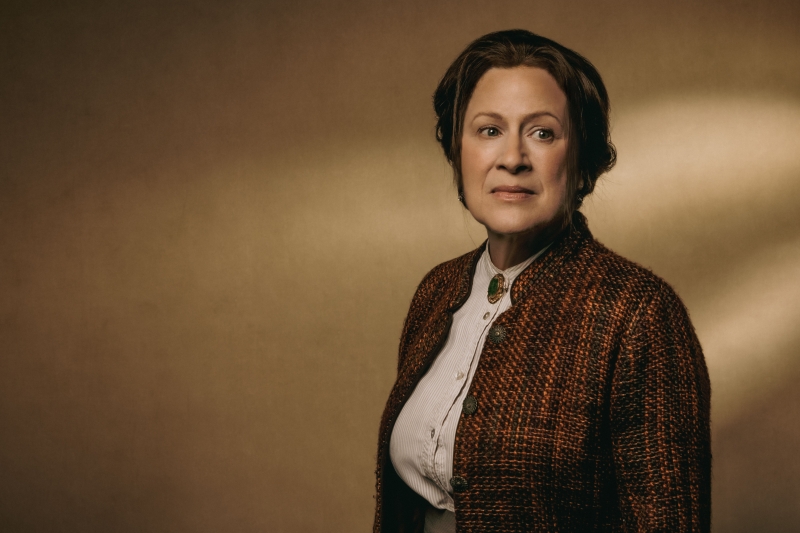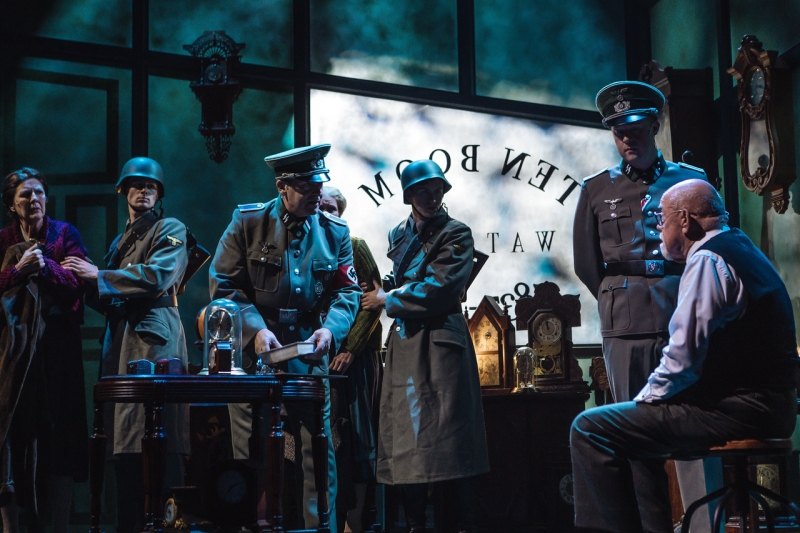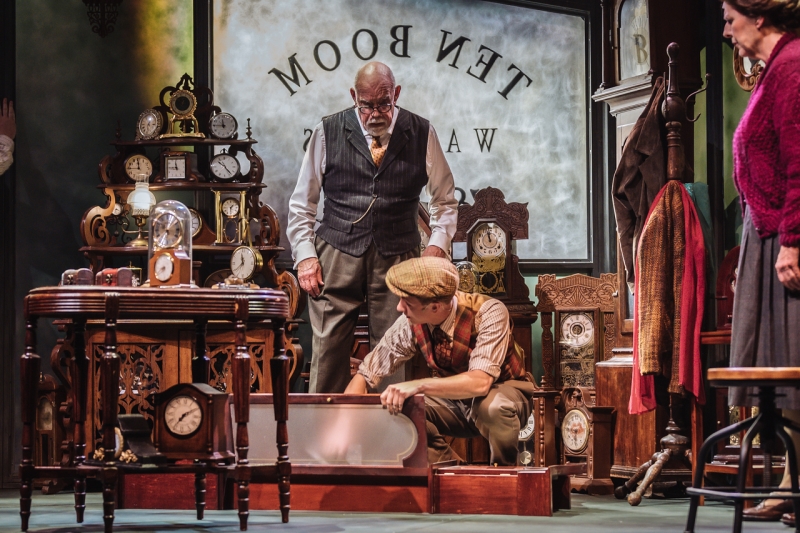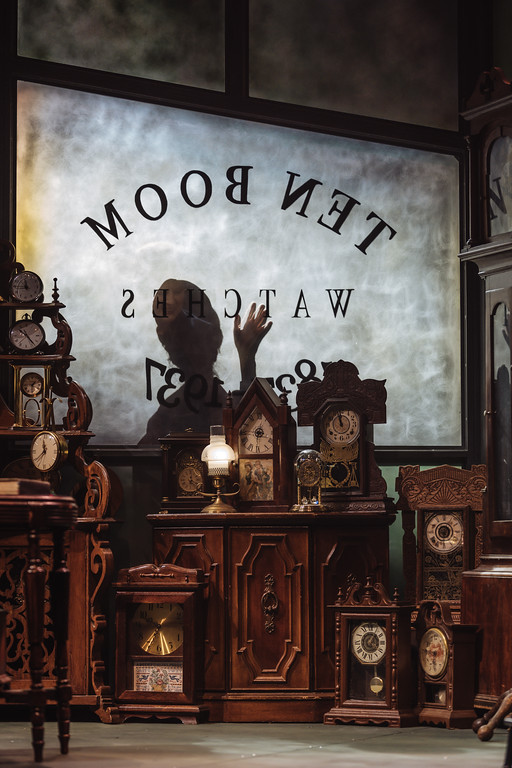Review: Matt Logan Directs 'Stunning, Powerful, Deeply Moving' THE HIDING PLACE in Nashville Premiere
A.S. Peterson's Adaptation of Corie Ten Boom's Memoir Marks Auspicious Debut for Rabbit Room Theatre

Stunning. Powerful. Deeply moving. The words come rather easily in an attempt to adequately describe the awe-inspiring performances to be found in director Matt Logan's beautifully crafted production of A.S. Peterson's The Hiding Place. Now onstage in its Nashville premiere at the Soli Deo Center (which, to be frank, is equally notable and worthy of excessive praise) at Christ Presbyterian Academy through July 23, the play - which had its premiere in September 2019 at A.D. Players in Houston, Texas - proves to be both accessible, engaging and, we daresay, hopeful even as it tells a story from one of the darkest eras in human history.
Based upon Corrie Ten Boom's widely read and venerated memoir of the same name, The Hiding Place focuses on efforts by the Ten Boom family to save Jews in The Netherlands from being sent to almost certain death during the Nazi occupation of the country in the 1940s. And just as importantly, it offers a soul-searching reflection on the faith of Corrie and her devout Christian family who regard anyone, everyone, as worthy of life, respect and redemption at a time it must have seemed impossible to hold true to their beliefs. In that manner, Peterson's play - exquisitely written and artfully structured - radiates with an authenticity and immediacy that is only possible through a live, onstage production.

- photos by MA2LA
Nashville theater icon Nan Gurley's bravura performance as Corrie Ten Boom (her understudy Rona Carter, an equally accomplished actor on local stages, opened the show's run in the leading role) is startlingly authentic - so much so that she may well have provided inspiration for Peterson as he wrote his epic play, and her onstage and offstage history with Logan no doubt adds to her impeccable performance. Gurley and Carter's Corrie is given support both expressive and extraordinary by Carrie Tillis as Betsie Ten Boom, Conrad John Schuck as Casper, Garris Wimmer as Willem and an impressive roster of Nashville stage veterans and newcomers alike who bring the story to life with vigor and determination unlike anything we've ever encountered on a Nashville stage (and, we should point out, we've been on this beat for well over 40 years, so we know whereof we speak).
Corrie Ten Boom's The Hiding Place has provided inspiration for writers, composers and other creators of art for at least 50 years - her book was published in 1971, co-written by Elizabeth and John Sherrill when their research unearthed the details of the Ten Boom family's efforts in the Dutch underground and resistance of World War II - and the 1975 film treatment of the story is perhaps the best known and most beloved product of that aforementioned creativity. Since then, it has inspired countless ruminations on the abiding faith and resolute determination that led Corrie, her sister Betsie, brother Willem and father Casper to risk their lives for people they did not know yet cared for all the same.
As we get to know the Ten Booms just prior to the German occupation of The Netherlands, we learn the history of the family's watchmaking business that was a part of Haarlem life for more than a century (in fact, Corrie Ten Boom was the first woman to be recognized as a watchmaker in Holland when, in 1922, she completed her studies in Switzerland and came home to claim her then-justified place in the family business), we are effectively drawn into their lives. And, as they become intimately involved in the Dutch underground, we gain a more resonant knowledge of who these people really were - or perhaps, more accurately, are.

Of course, the Ten Booms were not the only people to sacrifice life and freedom to provide hope and succor to the oppressed (particularly during the dark days of the Holocaust), but their story is nonetheless universally representative of everyone who has risked everything for other human beings in a time during which most were subjugated and some made to feel less-than-human by the atrocities that were part of the Nazi occupation of Europe.
Peterson's script unflinchingly captures the horrific realities of the Nazi occupation in Holland, yet somehow manages to sustain a sense of hope throughout the more than two-and-a-half hours of onstage storytelling. Thanks to Logan's sense of the theatrical and that which works best in delivering a difficult, yet ultimately uplifting, message, The Hiding Place rivets its audiences to their seats, their minds challenged by what transpires onstage before them and their very souls stirred by the deeply held faith that reverberates throughout even the darkest moments.
Logan's artistic vision - which melded with Peterson's in earlier collaborations on productions of The Battle of Franklin and Frankenstein for Studio Tenn, the company founded by Logan some years ago - provides the ballast that gives Peterson's page-bound story its lift to provide stirring visuals that bring the words to life. Logan's deft directorial hand ensures that the play's action (and make no mistake about it, this play is filled with so much action audiences could have been left breathless and despondent by the atrocities suggested) moves at a cinematic clip, underscoring the urgency of the events onstage.

The production's captivating musical score by Don Chaffer provides an added poignancy that underscores the story, lending an additional sense of time and place to the proceedings therein.
The gorgeously appointed set, designed by Logan in concert with Mitchell B. White (another of his longtime collaborators), provides an ideal backdrop for the play's many scenes with sets for the Ten Boom family shop and home (which, interestingly enough, was located only a block away from local Gestapo headquarters), and various internment and concentration camp settings and features technical wizardry that supports the storytelling with imagination and inventiveness, yet never goes so far as to suggest hoary special effects. As the characters of Peterson's play move from one moment to the next, the audience is taken along for an exhilarating ride that mirrors the unsettling reality of life's events and serves to immerse viewers in the story even more than they may realize. The details found in the set - from one scene to the next - are staggering and period perfect.
Logan's aesthetic for the production is informed by the sharply focused research evident in every production we've seen from him over the years and lends an air of authenticity to the play: his costumes for the production are expertly designed for both the purposes of storytelling and character development. Kudos to Allison Hearn for her extraordinary wig and makeup design that allows the actors to "find their characters" with greater ease, while Lauren Terry's wardrobe supervision plays a key role in that same area.

Of course, without the gorgeous lighting design by Stephen Moss, all these efforts, would be for naught - his illumination allows the eye to focus where needed, sometimes adding a sense of foreboding of what is to come or to suggest that a brighter future filled with hope may lie ahead. Likewise, attention must be paid to Danny Northup's sublime sound design which may well set the standard for anything we have yet to hear on a local stage.
But, as we recollect our memories from witnessing the artistry, creativity and imagination all brought together in a production that may well represent the zenith of local theater endeavor, we cannot help but be awestruck by the individual performances of Logan's amazingly gifted ensemble that, considered together, leaves us struggling to deliver the best description of the sum of all their parts.
Gurley, who over the years has put together a resume of theatrical performances that any actor would envy, is finally given a role that equals her tremendous talents and which allows her to create a beautifully etched characterization that we suspect theater-goers will talk about for much time to come. Likewise, Tillis delivers a performance of Betsie Ten Boom that is wonderfully heartfelt and endearingly hopeful and earnest: her scenes with Gurley are underscored by a pathos and the sheer beauty of artistic collaboration that is breathtaking.
 Schuck, whose body of work is all-encompassing, is commanding as the "grand old man of Haarlem" (as Casper Ten Boom was known in his hometown), exuding a fierce belief in what is right that proves a natural fit for the actor. Wimmer's performance is genuinely heartrending and the shared and pervasive sense of family among the quartet of actors is gratifyingly authentic.
Schuck, whose body of work is all-encompassing, is commanding as the "grand old man of Haarlem" (as Casper Ten Boom was known in his hometown), exuding a fierce belief in what is right that proves a natural fit for the actor. Wimmer's performance is genuinely heartrending and the shared and pervasive sense of family among the quartet of actors is gratifyingly authentic.
And while those four actors provide the play's strong central core, they are surrounded by the notable ensemble of players who bring countless other personalities - some good, some bad, some sub-human - to life with stark honesty. Nathaniel McIntyre is impressively focused as resistance leader Pickwick, while Ross Bolen is virtually unrecognizable as the efficient, officious and cruel Nazi lieutenant Richter and Jonah M. Jackson effectively plays against type as rude watch shop apprentice Otto, who rises quickly in the ranks of Nazis when he leaves to join the German army. Matthew Carlton is memorable as Fred Koonstra, a Ten Boom family friend, who heads the local food rations office.
Henry O. "Chip"Arnold displays his versatility as an actor by believably becoming one character after another, delivering a particularly compelling moment as a Ravensbruck inmate lashed to a crucifix during times that test Corrie's faith to its very limits as she struggles to recognize God's presence amid the horror.
Christi Dortch, making a welcome return to the stage after far too long an absence, is chilling as SS guard Irma Grese - aka "The Beast of Ravensbruck." Rona Carter, Deborah Seidel and Jenny Littleton provide strong support in a variety of roles as Jews fleeing oppression or concentration camp inmates yearning for a reason to live and hope. Special notice must also be afforded Annabelle Wolfe and Caroline Wolfe, who play younger versions of Corrie and Betsie and who in the process hold their own with their more experienced counterparts.
.jpg)
Others in the cast - who must be commended for their similarly effective performances - include Tiger Dulaney, Joel Hadden, Anna Claire Perry and standbys Wesley Paine and Ben Friensen. With this ensemble, Logan provides his production with an abundance of theatrical riches.
The Hiding Place runs for another two weeks (through July 23) at Christ Presbyterian Academy's impressive and glittering new performing arts center - The Soli Deo Center - and we rejoice in the fact that the theater program there nurtured by Paula Flautt now has a venue worthy of her many theatrical triumphs.
If you remain unconvinced of your need to see this show, after all these words and impressions we've shared, we can only add an earnest and sincere plea to Messrs. Peterson and Logan to ensure this stunning play has a life beyond what has already come to be. Your epic undertaking deserves and, in fact, demands a wider audience.
The Hiding Place. Based on the book by Corrie Ten Boom, adapted for the stage by A.S. Peterson. Directed by Matt Logan. A Matt Logan Production, Presented by Rabbit Room Theatre, at The Soli Deo Center, Christ Presbyterian Academy, Nashville. Stage managed by Dan Brewer, with assistant stage management by Nikkita Staggs and Brooks Bennett. Through July 23. Running time: 2 hours, 45 minutes (including a 15-minute intermission). For further details and for reservations, go to www.RabbitRoomTheatre.com.
THE HIDING PLACE production photos by MA2LA
Reader Reviews

Videos

